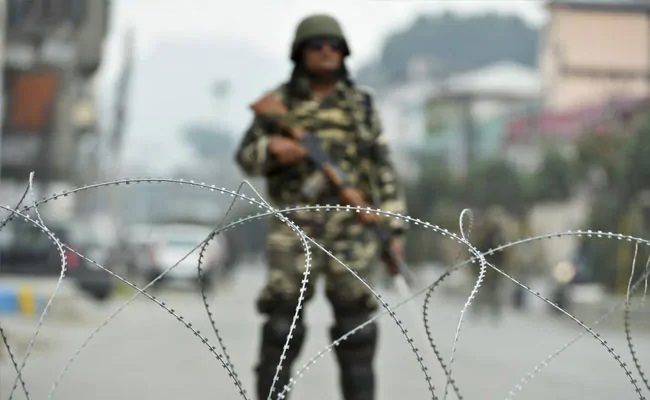Incidents of encounters between security forces and terrorists attempting to infiltrate across the Line of Control (LoC) in J&K are common. Though the police leaves no stone unturned to establish the identity of deceased terrorists by checking records, soliciting assistance of locals and even releasing their photographs for public scrutiny. Yet, if the identity of the deceased cannot be established, the dead are buried as per Islamic customs. In case some claimants do emerge subsequently, the body is exhumed and handed over to the family members. But this is done only after a DNA test confirms relationship of the claimant with the deceased and though not common, such incidents do occur periodically.
On May 25, 2018 five unidentified terrorists were killed in Tangdhar sector near the Line of Control (LoC) in the Bhadwan area of North Kashmir’s Kupwara district. However, after their photos were circulated on social media, relatives of two of the deceased approached the district administration claiming relationship to the slain terrorists. They were identified as Shiraz Ahmad belonging to Lajoora village in Pulwama district who had joined terrorist ranks in 2017, while the other was Mudasir Ahmad of Parigam village in Kulgam district who had disappeared in 2016. Once the identities of the deceased terrorists were confirmed through DNA tests, their bodies were exhumed and handed over to their family members.
A month later, on June 29, 2018 a terrorist was killed in a gunfight with the army in Kachama forest of North Kashmir’s Kupwara district and since his identity could not be established, he was buried as an unidentified terrorist. However, some days later, one Ghulam Ahmad Bhat, resident of Nasti Mohalla, Old Barzulla, Srinagar, submitted an application to District Magistrate Kupwara intimating that after seeing the photograph of this unidentified terrorist on social media and later at the local police station, he realised that it was his son named Mudasir Ahmad Bhat. It later emerged that even though Mudasir had gone missing since 2016, since his family members never filed a missing report, the police weren’t aware of Mudasir having joined militancy. After DNA tests confirmed his father’s claim, the body of Mudasir was exhumed and handed over to him.
The reason for citing these two incidents is only to highlight the harsh reality that terrorist groups often disown their dead in order to conceal the exact magnitude of their losses, even if it results in the deceased being buried unsung and as an unknown entity, far away from their native place. Resultantly, the unfortunate family members of such deceased terrorists are only able to establish the identity of their kith and kin after they have seen their photos that have been released by police and the time lag between release of photos and identification by family members may vary from a few days to even weeks or months.
However, the sequence of events starting from the encounter, followed by photos of unidentified terrorists being released, relatives identifying their kin from the same and thereafter approaching the authorities to claim the dead bodies, that has remained unchanged ever since terrorism erupted in Kashmir three decades ago, now seems to be a new trend!
On April 5, the Indian Army gunned down five terrorists near the LoC in Keran sector of North Kashmir’s Kupwara district. However, even while identification process of the deceased was still in progress and their photos hadn’t been released, people claiming to be related to three of them (two families from Shopian and one from Kulgam) had already reached Kupwara to claim their bodies. Such a development is both unprecedented and interesting, because it’s inconceivable as to how, without even seeing photographs of the deceased, family members of three slain terrorists are so sure of their identity that they have even reached Kupwara all the way from South Kashmir!
The most logical explanation is that due to the fear of being castigated by the international community for continuing its proxy war in Kashmir through cross-border terrorism even during times of Covid-19 pandemic, Pakistan Army has instructed terrorist groups not to issue their standard statements declaring the deceased as ‘martyrs’ and lauding their ‘valour’. But since three out of the five slain terrorists are Kashmiris, the terrorist group to which they belonged didn’t want to risk incurring public wrath by concealing their identity. So, instead of making a public announcement, they decided to quietly convey this news to family members of the deceased through their over-ground workers (OGWs).
But Islamabad is literally getting away with murder only because New Delhi’s counter-offensive on Pakistan’s proxy war is woefully pathetic. Compare the consistency of Islamabad’s Kashmir rhetoric, with New Delhi’s knee-jerk response to Pakistan Army’s brazen patronage of proscribed terrorist groups. Be it the South Asian Speakers’ Summit on ‘Achieving the Sustainable Goals’ in Maldives, UNICEF’s South Asian Parliamentarian Conference on Children Right’s Convention in Colombo, Sri Lanka or even the recent SAARC head of states video conference on Covid-19, Kashmir was the common denominator everywhere, despite being totally out of context.
In contrast, despite Pakistan being encumbered by a surfeit of vulnerabilities, New Delhi’s diplomatic riposte is inexplicably so feeble and irresolute that the lesser we talk about it, the better it is!

